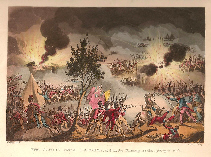Historical review in a few dates > Bibliography
In 1813, the defeat of Vitoria forced the French troops to leave Spain.
Joseph Bonaparte fled to Saint Pee sur Nivelle. He was dismissed July 11 and the defense of the Pyrenees border was entrusted to Marshal Soult with 35,000 men. On the opposite side, the Duke of Wellington had 100,000 men, including 57,000 English, 21,000 Spanish, 25,000 Portuguese soldiers.
► 7/9 October 1813: Battle of the Borders and Bidassoa
With a bridgehead at Hendaye, the Allies gained a substantial foothold on French territory - Soult's troops regroup on the Nivelle. Wellington settles in Saint-Jean-de-Luz.
► 10/11 November 1813: Battle of the Nivelle - The Invasion.
The French center is routed; French troops withdraw to Arcangues, Arbonne, Bassussary and along the Nive.
► December 9, 1813: Battle of the Nive and Arcangues
Wellington is always very cautiousam. Hampered by bad weather and fearing a trap, it does not take advantage of his victory at the Nivelle to press the French during their successive retreats. Soult goes on the offensive to clear Bayonne. The offensive is bogged down due to weather and the deplorable desertion in the midst of the battle by 11,000 men of the German Brigade. The British cross the Nive.
► The encirclement of Bayonne : December 13, 1813
Battles of Saint-Pierre d'Irube and Mouguerre.
Soult’s initial success is compromised by the failure of the reserve troops. Soult retreats to Bayonne.
The British reached the Adour downstream of Bayonne in front of Le Boucau.
► 14/23 February 1814: Fighting on the Joyeuse, the Bidouze and the Saison: withdrawal of the bulk of French troops to Orthez then Toulouse. Bayonne is declared under siege.
► The Siege of Bayonne : February 22 to May 8, 1814
It only really began after the crossing of the Adour by the allies on the night of February 22 to 23, in the narrowest place downstream of Bayonne - fighting of "La Sapho" - then by the occupation of the heights of Saint-Etienne and of the crossing of the roads to Paris and Toulouse at crossroads Matras.
The blockade of Bayonne is finalized on February 27, 1814. In Bayonne, 13,000 defenders will stop the advance of nearly 30,000 allies.
► The Sortie of the April 14, 1814: battle of Saint-Etienne. Temporary recovery by the French of the heights of Saint-Etienne and of the major crossroads. Death of English General Hay and capture of General Hope, commander of the Allied troops around the Vigneau.
These were the last shots of a Spanish conflict that began in May 1808 in Saint-Léon/Marrac, on the other side of the town of Bayonne town.
► Bayonne did not capitulate. The Siege was lifted May 5, 1814, well after the occupation of Paris by the allies (March 31) and the abdication of the Emperor (April 6, 1814)












